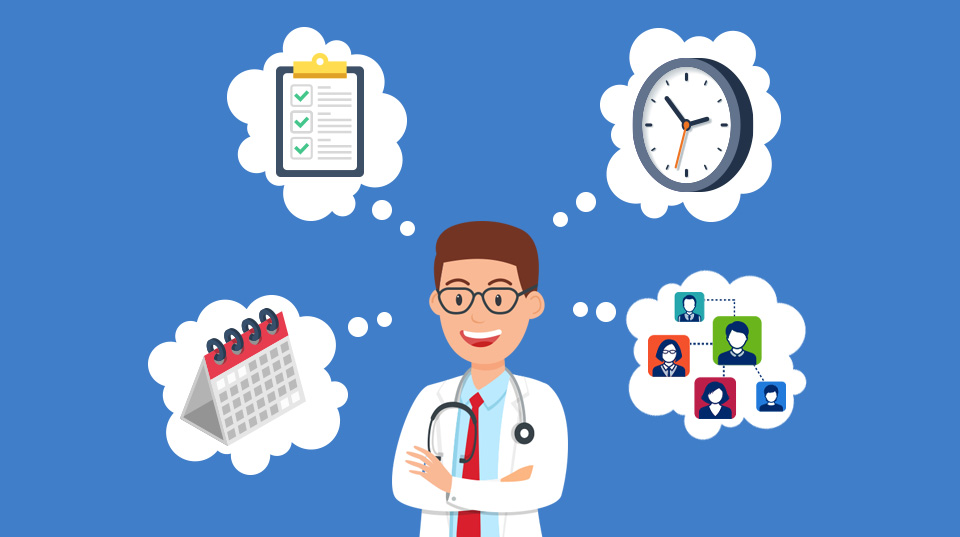Career resources content posted on NEJM CareerCenter is produced by freelance health care writers as an advertising service of NEJM Group, a division of the Massachusetts Medical Society and should not be construed as coming from, or representing the views of, the New England Journal of Medicine, NEJM Group, or the Massachusetts Medical Society
The primary care physician (PCP) may no longer be an endangered species. The patient-centered medical home (PCMH) has the potential to revolutionize the practice delivery model for PCPs. For physicians, this results in more manageable workloads, increased compensation, more time spent directly with patients, and rediscovering the joys of medicine. For patients, PCMHs facilitate more time and improved communication with physicians, enhanced accessibility, and easier navigation through the health care system. For physicians and patients alike, satisfaction and outcome measures improve.
— John A. Fromson, MD*
By Bonnie Darves, a Seattle-based freelance health care writer
Physicians —in both primary care and the specialties— may soon reap benefits from the patient-centered, coordinated care model taking hold.
Most primary care physicians (PCPs) today can hardly imagine a time when they might be able to spend more time with patients, operate their practices more efficiently, deliver top-notch yet individualized care, and actually be compensated for their role in directing that care. But that’s the promise of the patient-centered medical home (PCMH) concept, which entails providing team-based care led by a personal physician who provides continuity and coordination to improve patient’s health outcomes.
The PCMH is now making its way off the drawing boards and into the practice realm. In dozens of national and regional pilots, as well as a host of solo-physician “micro” medical homes, the reengineering of the notoriously dysfunctional U.S. primary care system has begun. In January 2009, the Centers for Medicare and Medicaid Services (CMS) launched its three-year Medicare Medical Home demonstration, in which eligible primary care and subspecialty practices that demonstrate their ability to deliver accessible, continuous, and coordinated care to “high need” patients will receive monthly medical home payments.
Other large-scale initiatives include the Commonwealth Fund’s national medical home initiative for safety net clinics, which will involve up to 80 clinics in six regions. The Patient-Centered Primary Care Collaborative also supports a national PCMH model and commitment to reporting on the progress of pilots underway. Finally, the National Committee on Quality Assurance developed a special recognition program for practices that meet PCMH criteria, which is beginning to translate into reward programs and improved reimbursement for physicians.
One goal for the PCMH is that its structure, in which a patient’s personal physician directs and coordinates all care and is compensated accordingly (see below), will attract more physicians to primary care. At present, the widely reported combination of inadequate incomes, high practice overhead, and punishing workloads has deterred many medical students from considering family practice, internal medicine, and pediatrics.
The promise of the medical home replacing the primary care “treadmill”— in which PCPs have been gradually pushed toward shorter and often unfulfilling patient visits – proved compelling enough to bring Washington family physician Suzanne Spencer, MD, out of retirement. Dr. Spencer retired briefly after spending three decades at a largely geriatrics-focused practice with Seattle-based Group Health Cooperative (GHC). She returned after witnessing what GHC’s recent medical home pilot, which she initially led, was achieving.
“I thought, ‘I’m having such a great time. How can I leave family medicine now when I now have more time with my patients because we have a team organized around them, and I see that we’re making an impact?’”says Dr. Spencer. “All of a sudden, I was having fun again after I’d been feeling burned out and frustrated.”
This year, Dr. Spencer is spearheading the rollout of GHC’s PCMH to all primary care practice sites on the heels of the pilot’s success. Preliminary data show improved patient and staff satisfaction, higher quality care, and better overall utilization.
GHC’s medical home – whose technological foundation is an electronic medical record–increases the use of support staff in patient education, communication, and outreach; promotes broader use of physician-patient e-mail; and calls for tighter care continuity when patients move between care settings. GHC also now has a designated clinical pharmacist at each clinic to address doctors’ or patients’ medication questions or concerns. The reconfigured phone system enables patients to speak directly to a person on their care team. The team includes the physician, medical assistant, and the LPN one of which can be reached within seconds of calling. Laboratory and other test results are fast-tracked to the primary physician, who is often able to deliver information to patients within hours. GHC has increased its PCP ranks on the premise that reducing patient panels will pay dividends in improving health outcomes by staving off chronic illness.
Eric Seaver, MD, an associate physician at GHC’s piloting Factoria Clinic on Lake Washington’s east side, is already experiencing the PCMH’s promise and professional benefits. “The model we’re using is actually like the vision I had in medical school of how I would practice –being able to take care of the whole patient, getting to know him or her, and truly addressing not just the hypertension or the blood sugar but also the stress around the marital relationship that’s leading to overeating or not exercising,” Dr. Seaver says. “I now have the clinic staff lined up to support that relationship.”
Of note, Dr. Seaver is GHC’s heaviest user of secure patient e-mail; he sends out more than 350 messages a month to discuss lab results, make diet or medication recommendations, or simply encourage a patient who’s hit a rough spot. His patient visit numbers have dropped considerably in tandem with his increased e-mail usage.
“It’s now rare that a patient comes in just to follow up on labs or blood pressure (BP),” Dr. Seaver explains. “Usually, we’re monitoring BP at home, and six months later, it’s time to come in to address that or other issues.” Today, most of Dr. Seaver’s patient visits are coded as 99214s. These are at the moderate level, he notes, because he spends 20 to 30 minutes with patients and takes care of multiple issues.
“We have fewer visits but more time, and now, there’s a built-in cushion between patients to check calls or look up lab results. The pace is definitely slower,” he says.
Despite the GHC pilot’s nascence – it’s barely two years old –practice efficiencies are accruing noticeably. On a single day in January, Dr. Seaver’s clinic care team handled 58 patient phone calls, several of which prevented unnecessary visits, and the average patient wait time was only eight seconds.
Large-scale, multiple-site PCMH pilots hope to eventually achieve similar results – and keep PCPs from jumping ship. Marjie Harbrecht, MD, medical executive director of Colorado Clinical Guidelines Collaborative (CCGC), which launched its PCMH pilot in spring 2009 with 17 practices, is all too familiar with the frustration and exhaustion Dr. Spencer describes. In her encounters with PCPs, a common theme unfolds.
“What we hear is that [primary care] doctors are working very hard – too hard. They go through a strenuous training process, start a practice, and then discover that they’re on a treadmill,” Dr. Harbrecht observes. “Then they have to just keep running. If doctors are on a treadmill, it’s hard for them to sit back and say, ‘How do I rework my system?’ ”
Physicians who participate in CCGC’s medical home pilot are excited about the program’s system-improvement potential and downstream benefits for patients and themselves. “For the doctors we’re talking to, it’s the thought of rediscovering the joy of medicine and getting away from the sense that everything is on their shoulders,” Dr. Harbrecht says. Implementing efficiency-boosting systems “will give them more time with patients. We’ve had some PCPs who were ready to hang it up because they’re so frustrated. This [pilot] has reinvigorated them.”
Small Practices Design Their Own Medical Homes
In cities and towns throughout the country, some frustrated PCPs have decided not to wait for the results of the pilots; they’re creating their own PCMHs. One is Amy Solomon, MD, of Ben Lomond, California, outside Santa Cruz. After 12 years of practicing in the “corporate environment” and feeling increasingly disconnected from patients, she decided to go solo and devise a medical home that reflected her values and the community’s needs.
“I spent two Saturdays outside Johnnie’s Super Market and surveyed my patients, asking them what they wanted and how far they would be willing to travel to see me,” Dr. Solomon says. Patients wanted not only longer individual visits but also group visits, in-practice access to alternative medicine providers, and yoga, fitness, and meditation workshops onsite. “And they asked me to get rid of those ‘gross paper gowns,’ ” she quips and become an eco-certified facility.
Both the local independent physicians’ association and her bank have been supportive – practically and financially – of Dr. Solomon’s medical home practice, which opened in March 2009. “I’m finally practicing the way I always wanted to, and I’m truly a part of the community now. I’m only 42, but I’m very much the old-fashioned family doctor.”
Eugene, Oregon, family physician Pamela Wible, MD, is nearly three years into her medical home-type practice, which came about as a last ditch effort to save her career. She had become so disenchanted with what she terms “the primary care assembly line” after a decade in three different practices that she was ready to leave medicine. “It was so production driven, not relationship driven. I was distraught,” she recalls.
Rather than abandon her profession, she decided in 2005 to create a medical home, one designed by her patients. “I held town hall meetings and asked patients what they wanted. The main thing was a humanized experience,” Dr. Wible explains. “And they didn’t want to be rushed. They wanted longer visits, 30 to 60 minutes. One patient wanted to be allowed to speak uninterrupted about her perception of her health issues for the first 10 minutes.” Patients even offered Dr. Wible their ideas on how the practice should look, and some presented her with drawings.
Dr. Wible incorporated – to the extent feasible – all the good ideas patients proposed. Within a year, she had regained her love of medicine, and streamlined her finances by reducing overhead and discontinuing contracts with insurers that reimburse poorly. Her new model of spending more time with patients but reducing the number of visits even improved relationships with her specialist colleagues. “When I send a patient to a specialist, the consultant has a much larger view of who they are dealing with,” she says. “And because I have more time in general, I can have more in-depth conversations with consultants, which they appreciate.”
Naysayers Nearly Nonexistent
What is a bit unusual about the PCMH movement as compared to many health care issues and developments that are debated on Capitol Hill, in care-delivery environments or in corporate boardrooms is that, conceptually, at least, it has sparked scant controversy. The PCMH is gaining acceptance largely because nearly everyone agrees that the predominant primary care arrangement serves no one well.
Physicians are overworked and undercompensated for the coordination they do provide, and many have unreasonably large patient panels. Patients are frustrated by poor access to PCPs, rushed visits, and their inability to navigate the complex health care system. Employers and payers are increasingly unwilling to pick up the tab for care that is often fragmented and expensive.
“We have a primary care system that does not work for the United States the way we know that it should,” observes Michael Barr, MD, MBA, vice president for practice advocacy and improvement at the American College of Physicians in Philadelphia. The payment system doesn’t support the kind of care that we want, and frankly, practices are not organized the way they need to be to deliver that care.”
Dr. Barr acknowledges that many examples of excellent primary care exist today, and that practice innovation and redesign, where it occurs, is paying dividends for patients and physicians. The problem is this: practices that deliver highly coordinated, accessible primary care supported by technology and communication that help mitigate unnecessary visits are still few and far between.
“The idea of the PCMH is that we will create a system at the micro level that will ultimately affect the macro level by providing a framework, tools, and resources—and the payment mechanism, of course, to support this kind of care,” Dr. Barr explains.
Payment Methods Being Tested
A range of payment methods have been proposed or are currently being tested to compensate PCPs for serving as medical homes. Most, like the CMS’s and the Colorado pilot, involve a per-patient monthly management fee (of roughly $40 or more, depending on the population served) on top of the fee-for-service payment or other reimbursement. Some methods add a performance bonus for meeting targeted quality indicators, and certain payer/insurer initiatives also incorporate a prospective payment to help practices absorb technology costs.
In current PCMH models, referral relationships between PCPs and specialists would not change materially from the standpoint of how specialists treat the patients referred to them by PCMH practicing physicians. Ideally, however, the specialists would be equipped – from a technology and communication perspective– to support the high degree of care coordination the medical home calls for. Those specialists could benefit, Dr. Barr suggests, because the patients referred to them would be more thoroughly worked up than in the past, ensuring more informed consults.
Ultimately, PCMH funders hope the model will improve health, not just health care, and reduce costs to the system as a whole. The American Recovery and Reinvestment Act of 2009, signed into law in mid-February, earmarks $19 billion for health information technology (HIT). Most PCMH models call for significant HIT enhancement and $500 million for health care workforce programs, including primary care training grants, a historically underfunded area.
In Dr. Barr’s view, the PCMH could translate into vastly improved practice conditions and more gratifying patient relationships for all physicians, not just PCPs. “Residents and young physicians,” he explains, “are already experiencing the dysfunction of the health system and are frustrated by it. I hope they see that a variety of different stakeholders are supporting the PCMH concept with the recognition that what we have can be improved.”
Even the PCMH’s most vocal proponents acknowledge that moving the model into widespread use and retooling practices to deliver highly coordinated care will be no small feat. And as Dr. Harbrecht notes, some envisioned elements of the medical home may not deliver on their promise.
“The pilots under way now will have successes and failures, and we’ll learn from both,” Dr. Harbrecht maintains. “We know, too, that it’s a tough road ahead because there are a lot of moving parts to the PCMH model, and there will be pushback from physicians and others. We also know that what we’re doing now isn’t working, for physicians or patients, so we must try something else if we’re going to save primary care.”
On the most basic level, the patient-centered medical home (PCMH) is a team-based care model led by a personal physician that provides continuous, coordinated care, ideally over the long term, to maximize health outcomes. This entails providing personalized primary care, managing and treating chronic illness, and arranging for needed specialist care or other health services in a practice environment characterized by expanded access and supported by information technology.
What differentiates the PCMH from most current practice structures is its emphasis on highly integrated – not fragmented –care delivery, as well as the designation of the primary physician as the coordinator –though not the gatekeeper –of all care.
The PCMH concept was first introduced in 1967. Of course, this raises the fascinating question: why did it take so long to gain traction? Indeed, it never truly rolled out, presumably because there was no “system” support for it by the American Academy of Pediatrics as a means of improving chronic disease care. It has gained ground in recent years across the entire spectrum of care as all parties involved in primary care – physicians, patients, payers, and policymakers – acknowledge that the current approach promotes uncoordinated episodic care and fails to recognize or compensate the important role primary care physicians do or can play in improving care.
The primary care professional societies published the Joint Principles of the PCMH in 2007. Since then, they have been endorsed by more than two dozen physician organizations. The principles are accessible online at the American College of Physicians’ PCMH section at https://www.aafp.org/dam/AAFP/documents/practice_management/pcmh/initiatives/PCMHJoint.pdf.
Resources
National Committee on Quality Assurance (NCQA). The NCQA’s Practice Connection Patient-Centered Medical Home recognition allows practices to obtain designation as medical homes on one of three levels. That recognition in turn may qualify physicians for extra payments and technical support from health plans. More details can be found at www.ncqa.org, under Physician Recognition.
Patient Centered Primary Care Collaborative (PCPCC). The PCPCC, a broad-based coalition that now includes more than 300 members, is working to advance the nationwide development and spread of the PCMH and an accompanying payment system. For details, go to www.pcpcc.net.
*Dr. Fromson serves as the editor for Career Resources and is Vice Chair for Community Psychiatry, Brigham and Women’s Hospital; Chief of Psychiatry, Brigham and Women’s Faulkner Hospital; Associate Professor of Psychiatry, Harvard Medical School.







